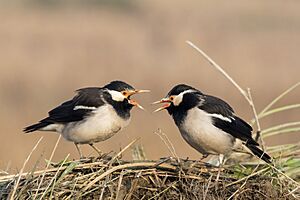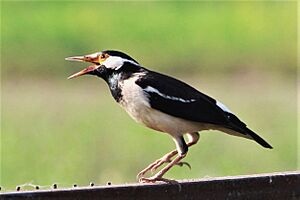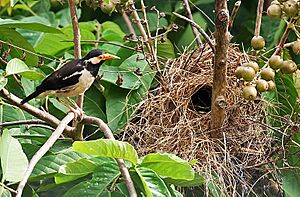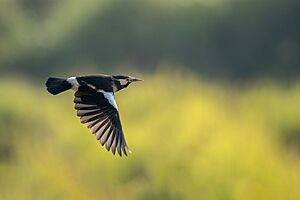Indian pied myna facts for kids
Quick facts for kids Indian pied myna |
|
|---|---|
 |
|
| Uttar Pradesh, India | |
| Conservation status | |
| Scientific classification | |
| Genus: |
Gracupica
|
| Species: |
contra
|
| Synonyms | |
|
Sturnus contra Linnaeus, 1758 |
|
The Indian pied myna (Gracupica contra) is a type of starling bird. You can find it in the Indian subcontinent, which includes countries like India and Bangladesh. These birds usually live in small groups. They prefer flat areas and low hills, often near cities and villages. They are known for their many different calls, which sound like liquid notes.
Contents
About the Indian Pied Myna
The Indian pied myna is easy to spot because of its striking black and white feathers. It has a yellowish beak with a reddish part at the base. The skin around its eyes is also reddish. Its upper body, throat, and chest are black. But its cheeks, parts of its wings, and rump are bright white. Male and female mynas look similar. Young birds, however, have dark brown feathers instead of black.
These birds fly slowly with round wings, almost like a butterfly. Sometimes, you might see a myna that is mostly white. This is a rare condition called leucism, which means it has less color in its feathers.
Where They Live
Indian pied mynas mostly live in flat areas, but they can also be found in foothills up to about 700 meters high. They like places with access to water. In India, they are mainly found in the Gangetic plains, stretching south to the Krishna River and east to Bangladesh.
Their living area is actually growing! They have recently started living in places like Pakistan, Rajkot, and Bombay. This might be because some birds escape from cages, or because of changes in farming and water systems. They have even made their way to Dubai in the UAE. These birds often live in open areas with scattered trees near water, and they are sometimes seen near places like sewage farms or trash dumps.
How They Behave and Live
These starlings usually hang out in small groups. They often look for food on the ground but will perch on trees and buildings. Birds in a group talk a lot, making many different sounds. These include whistles, trills, buzzing noises, clicks, and warbling calls. If young mynas are kept as pets, they can even learn to copy other bird songs!
Both male and female mynas sing. They search for food in fields, lawns, and open ground. They eat grains, fruits, insects, earthworms, and snails, usually picking them up from the ground. Like many other starlings, they have a special way of finding hidden food. They can push their beak into the soil or grass and then open it wide. This helps them find food that's hiding underneath. Their eyes are set up so they can see clearly into the space their beak creates. They often feed in areas where cattle graze.
Reproduction and Life Cycle
The breeding season for Indian pied mynas in India is from March to September. When it's time to breed, the large groups break up, and birds find a partner. During courtship, they call to each other, fluff up their feathers, and bob their heads.
Their nest is a loose, dome-shaped pile of straw with an opening on the side. They usually build it in a large tree like a banyan or mango tree. Sometimes, they build nests on human-made structures, often close to where people live. Several pairs might build their nests close to each other.
A female myna usually lays about four to six shiny blue eggs. She lays one egg each day, and she starts sitting on them to keep them warm (incubation) only after the third or fourth egg is laid. The eggs hatch after about 14 to 15 days. The young chicks stay in the nest for two weeks, with the mother staying with them at night. Both parents feed the chicks until they are old enough to fly and leave the nest, which is about three weeks after hatching. These birds can raise more than one group of babies in a single season.
Sometimes, a common myna has even been seen feeding a young Indian pied myna! At night, these mynas gather in groups to sleep together. They also work together to protect their nesting areas.
In Human Culture
Indian pied mynas are popular as pet birds because they can copy human voices. The Sema Nagas, a group of people, do not eat this bird. They believe it is a human who has come back to life as a bird. People generally think these birds are helpful because they eat many insects.
Images for kids
-
An early illustration by George Edwards (1751)







